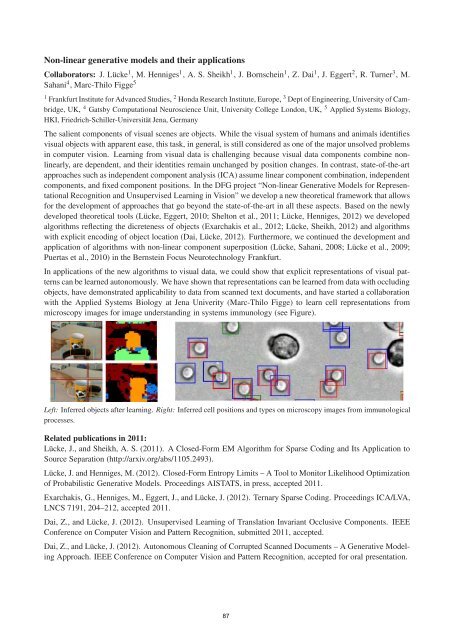FIAS Scientific Report 2011 - Frankfurt Institute for Advanced Studies ...
FIAS Scientific Report 2011 - Frankfurt Institute for Advanced Studies ...
FIAS Scientific Report 2011 - Frankfurt Institute for Advanced Studies ...
You also want an ePaper? Increase the reach of your titles
YUMPU automatically turns print PDFs into web optimized ePapers that Google loves.
Non-linear generative models and their applications<br />
Collaborators: J. Lücke 1 , M. Henniges 1 , A. S. Sheikh 1 , J. Bornschein 1 , Z. Dai 1 , J. Eggert 2 , R. Turner 3 , M.<br />
Sahani 4 , Marc-Thilo Figge 5<br />
1 <strong>Frankfurt</strong> <strong>Institute</strong> <strong>for</strong> <strong>Advanced</strong> <strong>Studies</strong>, 2 Honda Research <strong>Institute</strong>, Europe, 3 Dept of Engineering, University of Cambridge,<br />
UK, 4 Gatsby Computational Neuroscience Unit, University College London, UK, 5 Applied Systems Biology,<br />
HKI, Friedrich-Schiller-Universität Jena, Germany<br />
The salient components of visual scenes are objects. While the visual system of humans and animals identifies<br />
visual objects with apparent ease, this task, in general, is still considered as one of the major unsolved problems<br />
in computer vision. Learning from visual data is challenging because visual data components combine nonlinearly,<br />
are dependent, and their identities remain unchanged by position changes. In contrast, state-of-the-art<br />
approaches such as independent component analysis (ICA) assume linear component combination, independent<br />
components, and fixed component positions. In the DFG project “Non-linear Generative Models <strong>for</strong> Representational<br />
Recognition and Unsupervised Learning in Vision” we develop a new theoretical framework that allows<br />
<strong>for</strong> the development of approaches that go beyond the state-of-the-art in all these aspects. Based on the newly<br />
developed theoretical tools (Lücke, Eggert, 2010; Shelton et al., <strong>2011</strong>; Lücke, Henniges, 2012) we developed<br />
algorithms reflecting the dicreteness of objects (Exarchakis et al., 2012; Lücke, Sheikh, 2012) and algorithms<br />
with explicit encoding of object location (Dai, Lücke, 2012). Furthermore, we continued the development and<br />
application of algorithms with non-linear component superposition (Lücke, Sahani, 2008; Lücke et al., 2009;<br />
Puertas et al., 2010) in the Bernstein Focus Neurotechnology <strong>Frankfurt</strong>.<br />
In applications of the new algorithms to visual data, we could show that explicit representations of visual patterns<br />
can be learned autonomously. We have shown that representations can be learned from data with occluding<br />
objects, have demonstrated applicability to data from scanned text documents, and have started a collaboration<br />
with the Applied Systems Biology at Jena Univerity (Marc-Thilo Figge) to learn cell representations from<br />
microscopy images <strong>for</strong> image understanding in systems immunology (see Figure).<br />
Left: Inferred objects after learning. Right: Inferred cell positions and types on microscopy images from immunological<br />
processes.<br />
Related publications in <strong>2011</strong>:<br />
Lücke, J., and Sheikh, A. S. (<strong>2011</strong>). A Closed-Form EM Algorithm <strong>for</strong> Sparse Coding and Its Application to<br />
Source Separation (http://arxiv.org/abs/1105.2493).<br />
Lücke, J. and Henniges, M. (2012). Closed-Form Entropy Limits – A Tool to Monitor Likelihood Optimization<br />
of Probabilistic Generative Models. Proceedings AISTATS, in press, accepted <strong>2011</strong>.<br />
Exarchakis, G., Henniges, M., Eggert, J., and Lücke, J. (2012). Ternary Sparse Coding. Proceedings ICA/LVA,<br />
LNCS 7191, 204–212, accepted <strong>2011</strong>.<br />
Dai, Z., and Lücke, J. (2012). Unsupervised Learning of Translation Invariant Occlusive Components. IEEE<br />
Conference on Computer Vision and Pattern Recognition, submitted <strong>2011</strong>, accepted.<br />
Dai, Z., and Lücke, J. (2012). Autonomous Cleaning of Corrupted Scanned Documents – A Generative Modeling<br />
Approach. IEEE Conference on Computer Vision and Pattern Recognition, accepted <strong>for</strong> oral presentation.<br />
87
















